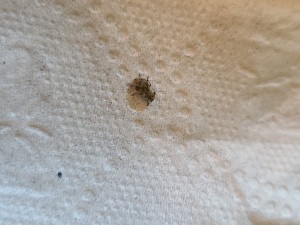 I am just wondering what kind of bug is this? I found it on me, but am not sure if it came from outside or not.
I am just wondering what kind of bug is this? I found it on me, but am not sure if it came from outside or not.
Picture not too clear but it resembles a tick to me.
There are several kinds and some are more prevalent in different parts of the country.
If it is a tick, you should check your body and clothing carefully as there may be others and if you have pets (especially dogs0 be sure to check them carefully every time they go out until you take care of any bugs in your yard.
www.google.com/
If you discover this is a tick here are some suggestions for getting rid of them if they're in your yard (if you have a yard).
www.thespruce.com/
If this is not a tick you really need to find out what it is for sure.
Correct removal is very important:
I used the liquid soap method on a camping trip and it worked but most sites recommend removal with tweezers.
www.mdedge.com/
This is a lice and it normally is found in your hair. They can jump from one head to another and lay eggs in your hair. If one is on your skin it could have come out of your hair.
It looks like some type of weevil that hitched a ride on you from outdoors. Nothing to worry about unless you have some plant growing outdoors that they like. Weevils drill into plant stems and veins to suck the plant juices. If it happens enough, it can severely damage or kill the plant. Then you would need to use some kind of bug control on the favored plants.
Here are the questions asked by community members. Read on to see the answers provided by the ThriftyFun community.
I found several of these arrow shaped sticker-like things in my hair. I also found them on my dog, which is a wire-haired mini daschund. They were very difficult to get off. A few days before, I had a sudden, multiple variety, bug hatching at my house and I'm worried about (eggs, disease) if they are bugs.
If not a bug, what are they and how did we pick these hitchhikers up?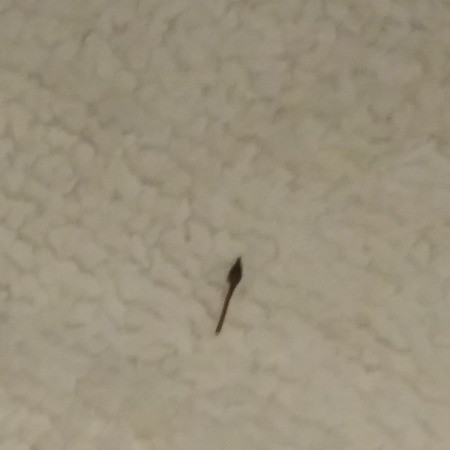
This appears to be a sticker (or bur). My understanding is these are NOT harmful unless they become lodged in an animal's skin, ears, or nose. So you definitely did exactly the right thing by plucking them off your doggo as soon as possible!
It doesn't look like beetle eggs or larvae. I think this is a part of a corkscrew seed (Filaree or Pelargonium or something else). These seeds have one end like an arrow, and the other end like a spiral (to screw into the soil). Perhaps the spiral part broke off when you pulled it out of your hair.
I have whitish tan little flecks and balls, also pepper looking balls that BITE! They dont move, just appear on my furniture, car,clothes.
I'm in Sacramento, CA. Anyone know what this is?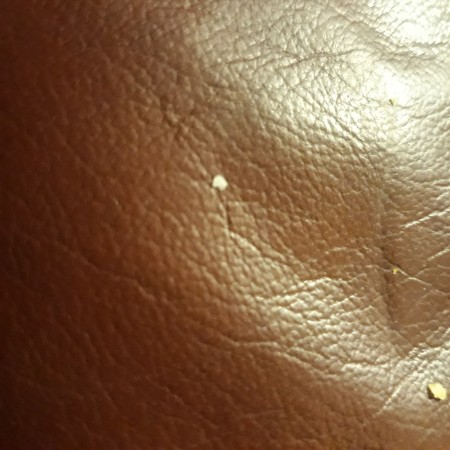
These look like the no-see-um bugs They are horrible and the bit really does some damage. Some people call these sand fleas and when they do bite they leave blister type bits on your skin that turn red and itch like crazy. They are so hard to get rid of and in some cases almost impossible. They do sell special window screens that you can put up in your home to keep them out of your house.
This is called Ceratopogonidae - better known as biting midges or no-see- ums. Very small and biting. Here is more info on them - en.wikipedia.org/
Not the best photos I know, but found a couple of these the past few weeks about the house, was wondering if anyone had an idea of what they could be. They don't fly, and don't move fast.
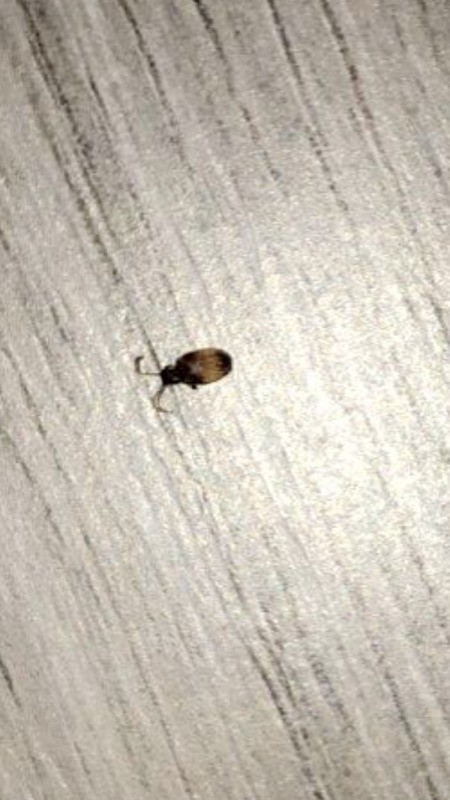
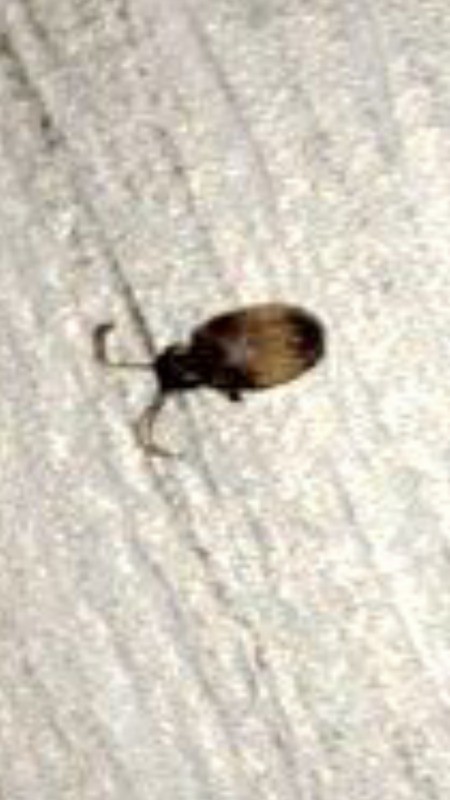
If you have found one there more than likely more around the house you haven't seen yet. These are a standard carpet beetle that comes into the home to eat the fibers of the carpet or even your clothes. These beetles feed on fibers. You will need to clean the home really well and vacuum them up. Be sure to throw the bag away in the trash when done. If you have a bagless cleaner empty the bag into a plastic bag and seal it up.
Looks like a basic carpet beetle. Vacuum them up, toss the bag (or dump the contents of the canister) and put it outside for the trash (far from the house). Unless you have a huge infestation (dozens and dozens) this will usually do the trick to get rid of them. It is also helpful to check around the house and clean up piles of yard debris as that is where they like to hide and them come in to the house. Post back with an update!
Is this a flea that is stuck in the trap? I think it is? Thanks!
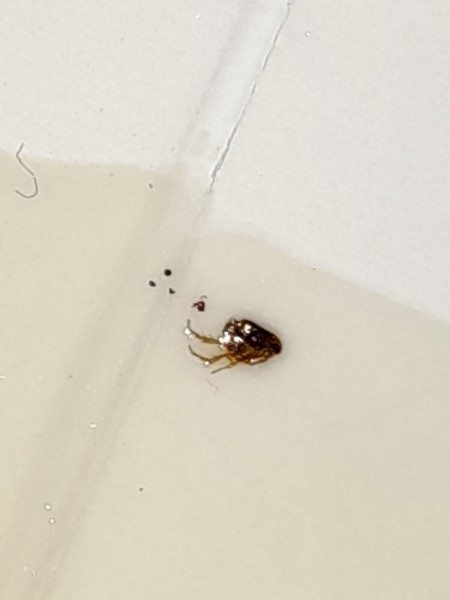
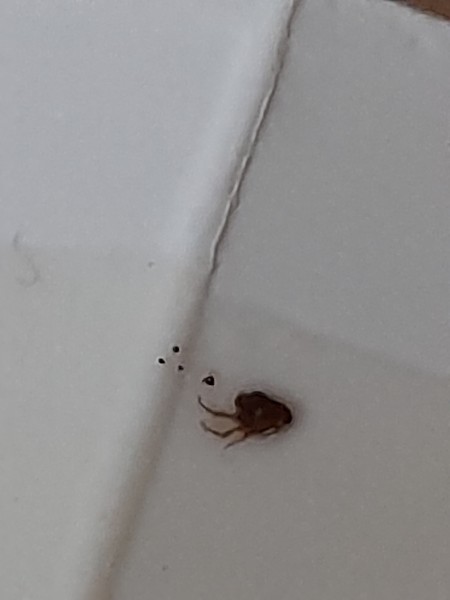
Sure looks like a flea..
What was the purpose of the trap?
What type of bug where you trying to catch?
If you have pets you will need to start a flea removal program quickly as fleas multiply fast.
DIY flea control is possible but it will take several weeks of constant working on the problem as the fleas have a life cycle so you have to work on their schedule.
I like using Diatomaceous Earth (food grade only) as it is not harmful to pets or people/children and very easy to use. You will probably need about 2 pounds to do a decent job and this is sold at most big market stores as well as online.
Wear a mask and sprinkle the DE all around the area where your pets hang out the most. Sprinkle any carpet (not all over but several areas) as well as sofa, chairs, pet bedding, etc as if will not harm any of these. Remember; sprinkle not clumps; you can use a small paint brush to spread the DE.
You can also rub it on your cat or dog but protect the eyes and nose. Just leave it on the pet.
You can vacuum the house after 3-4 days but repeat the process as DE is not an instant killer but it will kill the fleas and any other bugs that happen to cross the path.
www.thesprucepets.com/
If you have a yard you may have to think about defleaing it also.
If you do not have pets then you will probably have to think about how the flea got into your home.
So I have these bugs making trails under my skin. If you look close they look like mites attached to whatever fibers they find. I am just not sure what type but they are literally eating me from the inside out.
I had a parrot and they killed her and my goldfish as well. Please any help on what I can use to kill them.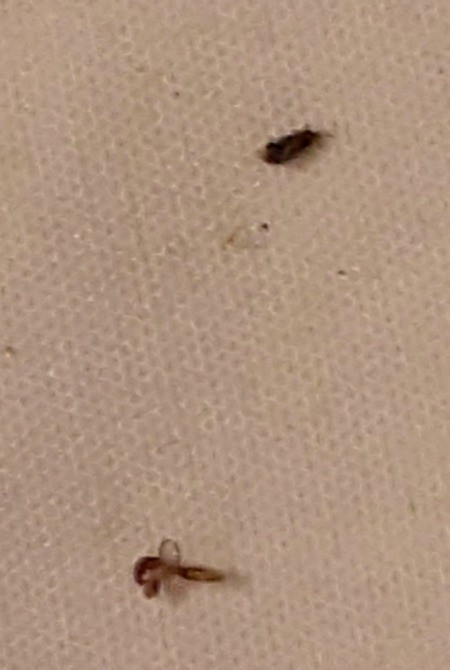
It sounds like you have bird mites due to the fact that you had a parrot in your home but there are other types of mites that are very similar.
It's possible your parrot was the host for bird mites and they are still lingering around since his/her death.
But where did the bird mites originate from that attached to your parrot?
You may have a bird nest in one of the eaves of your house or a nest very close by and until that nest is removed you will continue to have this infestation of mites in your home (and on you or anyone else in the house).
If you live in an apartment or a rental home you should contact your landlord immediately and tell them about your problem as they should be responsible for taking care of having your living space cleared of the bugs and the source. Exterminating of any kind will be expensive.
Here are comments made about how to deal with this problem:
"As with many pest control situations, eliminating the source of the problem often brings about rapid results, and bird mites aren't any different. If these pests are found, removal of a bird nest once the birds have left is the single most crucial step. Like flipping a switch, mite activity typically drops off rapidly within a day or two of the nest being removed."
You will need to determine that you actually have bird mites and most people have to call an exterminator to verify what is going on in your house and give you an estimate of the cost to take care of the problem.
But you can identify bird mites yourself; however, once you have identified the problem, you will still need someone to find the source and remove it or the problem will continue.
"TIP: To capture mite samples from a heavily infested room: Place a pan of hot, steaming water in the middle of a darkened room at night. Place a single light over the pan. Leave the room undisturbed for a couple of hours. You will need to use a strong magnifier to see them in the water. Place samples in a small container with alcohol to preserve."
This will give you a sample that you can take to your landlord, your county extension office or to an exterminator.
Here is a link to help you locate your county extension office.
ask.extension.org/
You can read about this problem on these links:
www.birdmites.org/
medent.usyd.edu.au/
A pharmacist can help you find products to help control the itching.
"Antihistamine creams or anti-itch creams, including those containing hydrocortisone, can help reduce itching. You can also take oral antihistamines for severe itching. If you have painful bites, anesthetic creams can help.
Mite bites often cause severe itching, but scratching can lead to infection. Its important to try to reduce the itch with medication, ice, or other treatments."
www.healthline.com/
What kind of larvae is this? It's absolutely infested my home. I see my sheets moving and kind of filling up. They're in my bathroom in the sink and I even washed them out of my hair.
They are under my skin and sometimes I see pointy flesh colored things poking out of my couch and bed.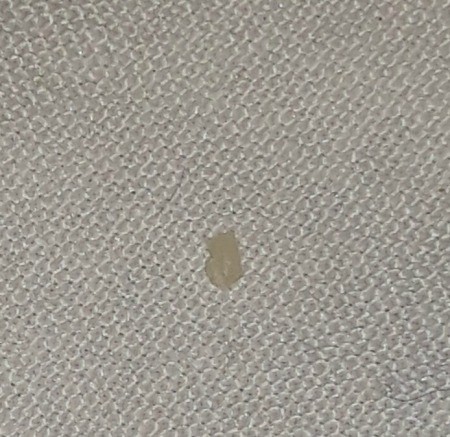
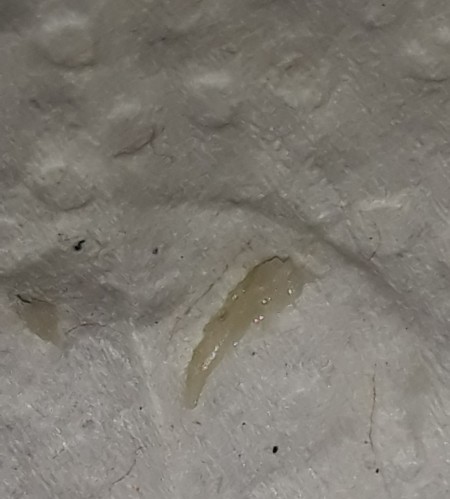
I do not believe we have successfully named your bug as you describe it as a biting bug.
I believe you need to send your pictures and description to your local county extension agency as they are familiar with such things in your area.
ask.extension.org/
www.gardeningknowhow.com/
You might take your pictures to either Ace or True Value hardware stores and ask for advice as they generally have very knowledgeable people working in these departments.
What is this giant looking ant / scorpion / earwig six legged horned back looking big? I live around Portland Oregon and have never seen one before in 20 years.
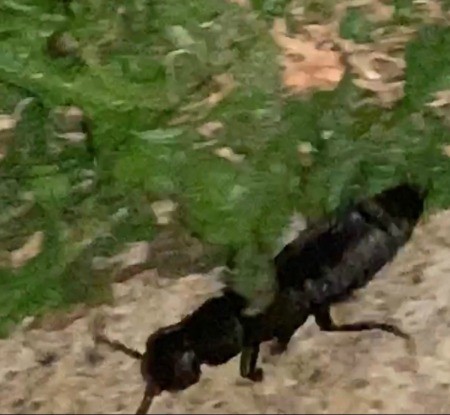
Check the site below, and scroll down 2/3 to 3/4 of the page to the Rove Beetle, also called the Devil's Coach Horse. I think that's what you pictured. It would be easier to help if there was a photo of side view also. If the Rove Beetle is not right, you might find what you're looking to identify, if you Google "large black ant-like bug".
www2.palomar.edu/
This is not a large ant. It is a rove beetle, sometimes called the Devil's coach horse (Staphylinus olens). These large, ground-dwelling beetles belong to the family Staphylinidae and are occasionally found in urbanized areas of coastal southern California during September and October. This beetle has short wing covers (elytra) and does not fly. When alarmed it exhibits a threat posture by opening its formidable mandibles and raising the tip of its abdomen (right image). Although the abdomen has no stinging device, this display serves to ward off enemies. The alarm posture is well deserved because this beetle can inflict a painful bite into your finger. Two glands at the tip of the abdomen emit a malodorous yellowish liquid. Both adults and larvae are voracious predators. According to C.L. Hogue (1974 & 1993), Insects of The Los Angeles Basin, this beetle feeds on garden snails and slugs. Although it was originally introduced from Europe around or before 1931, it is probably beneficial in your garden.
Translation from Google: Hello, I work in a hospital and a parasite has fallen on my head. They don't know about it here and I use all kinds of dog lice shampoo, repellents, oils, but it stopped a lot and I couldn't remove it, the doctor didn't want to prescribe anything and sent me to the doctor. psychologist, and the psychologist has told me that this is not a case of a psychologist. I took photos of the parasite, I don't know what to do anymore, a friend told me that it is the African louse and in Brazil there are similar parasites.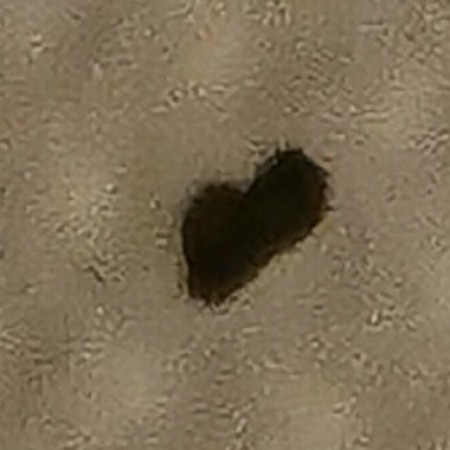
Original: Hola trabajo en un hospital y me ha caído un paracito en la cabeza aquí lo desconocen y huso de todo champú de piojos de perro, repelentes, aceites pero pare mucho y no logro quitarlo, el medico no me quiere recetar nada y me ha mandado al psicólogo, y el psicólogo me ha dicho que ese caso no es de psicólogo les lleve fotos del paracito, ya no se que hacer, una amiga me ha dicho que es el piojo Africano y en Brasil hay paracitos iguales.
I have been bitten/stung outside at night or late evening several times by these little black monsters. It feels like a wasp sting and continues to burn and feel like something is poking into my skin even tho there isn't.
Tiny little monster outside, maybe 3x the size of a flea. Does anyone know what this is and how do I get rid of it (and its entire bloodline )? I live in Alabama.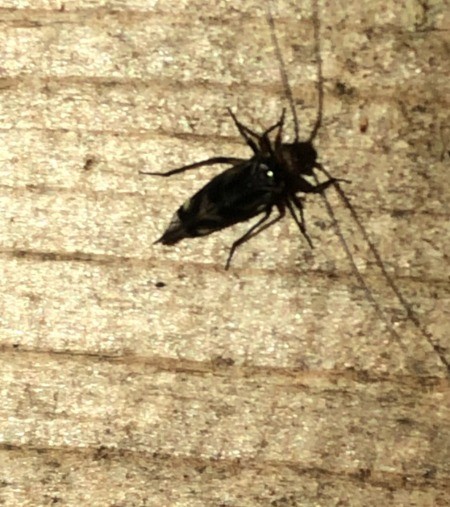

It's partially squished already but does anyone have any idea what kind of bug this is?

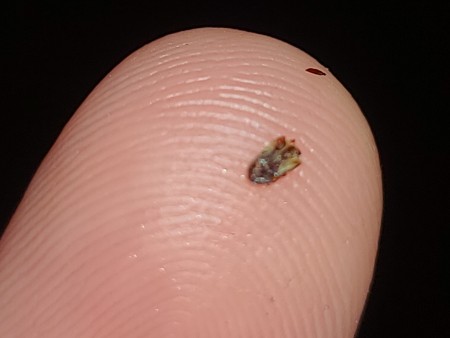
This looks like a small beetle that has come in your home from a grocery store or something that you brought home such as a box or a stack of books or papers. The beetle can be destructive if you allow them to breed and multiple in your home. If this is the only one then you should be fine. If you find more of them set out some flypaper to trap them and throw them away. You can also vacuum them up and throw them out in the trash.
Please anyone know what this is? Is it a parasite? It is about 3 cm in length.
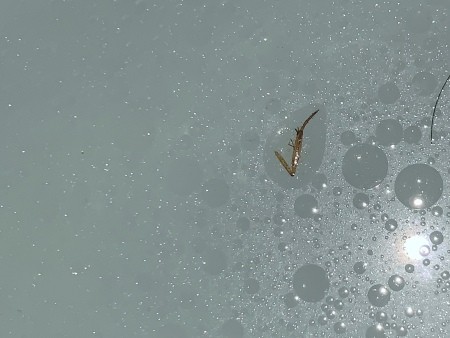
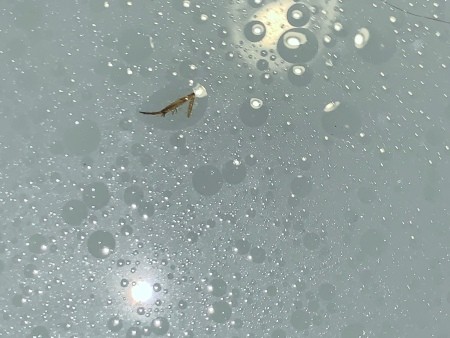
I started having bites on me a few years ago, and when I searched in carpet, I found these. There is a tiny little "leg" on the underneath, otherwise, it looks like a tiny maroon "bullet" with an attached round "head".
Anybody? P.S. They bite!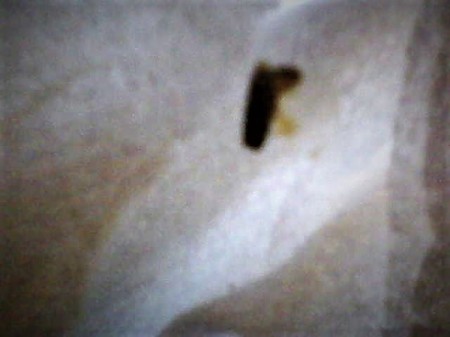
Arvada, CO
These look like carpet beetles. Vacuum very thoroughly and treat with boric acid.
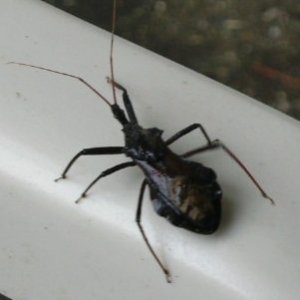 Can anyone identify this bug? One shows up every year in early fall.
Can anyone identify this bug? One shows up every year in early fall.
By Joan from Lewes, DE
Hello ~
I just found one of those bugs yesterday and I identified it as a sort of stink bug. Its official name is a western conifer seed bug according to the web.